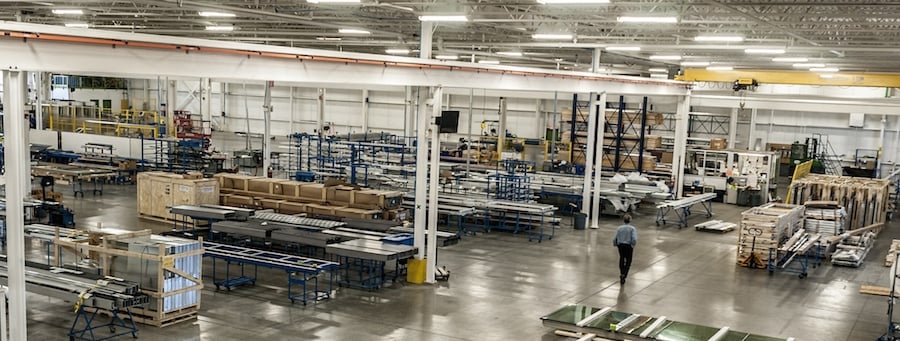
Whether I’m speaking to potential customers or other industry professionals at a trade show, I frequently get to talk about logistics in the industrial manufacturing space. And I always find myself asking these questions: “What type of product do you have, how is the product stored, how does the product flow through your current warehouse, and what type of material handling equipment are you working with?”
Regarding industrial logistics, so much depends on the sub-sector of your product. While there are still over-arching themes and best practices you see across every warehouse, the operations inside a warehouse vastly change based on the product. There’s no blanket or one-way solution that works across every industrial sector — customization and awareness of different sub-sectors are keys to an optimized warehouse.
If you’re looking for a 3PL to handle industrial manufacturing logistics, make sure they know about the following requirements before forming a partnership:
The Handling And Equipment Your Product Requires
From chemicals to alloys and from building materials to automotive parts—the variety of materials in the industrial logistics field can be overwhelming. It’s so incredibly important to understand these materials and having the proper equipment to handle them – especially when it comes to efficiencies.
Let’s take chemicals, for example. You have to ask: are they hazardous? How are they transported? Drums, kegs, on a pallet, or bulk? Is there proper containment and disposal of the containers? Is an exact temperature important?
These questions are just a small example of what goes into the handling of one product. If you look at something like alloys, other questions should come to mind:
What type of racking are they using? Do they have the means to hold oddly-shaped objects?
While forklifts are thought of as the main method of moving product through a warehouse, in the industrial sector, overhead cranes are also used when necessary. Is the 3PL you’re looking at able to handle heavier objects? Do they have more than one means of transporting/moving objects?
As you can see, how your 3PL handles a product and the equipment required to handle it can vary greatly in the industrial sector. It is important that your 3PL understands nuances and intricacies involved with your unique products and how to get them safely from point A to point B.
Your Key Metrics
When it comes to warehousing, it’s no secret space directly affects overhead cost—which directly impacts the overall manufacturing cost. Optimizing warehouse space is one of the best ways to keep costs down across the line.
These are the key, high-level metrics we suggest asking about as you choose the right 3PL for your industrial needs.
For inbound manufacturing:
- Inventory accuracy and control
- Sequencing accuracy (if applicable)
- Cycle times
For outbound shipping:
- Safety record
- Quality controls across the supply chain
- Line and order fill rate(s)
- Logistics cost per unit and/or per order shipped
It’s All About The Flow
Every situation is unique when it comes to logistics. We obviously handle fast-moving consumer goods differently than industrial service products—and for a good reason! Consumer goods are products that move at high volumes and velocity through the warehouse. The focus of a consumer goods warehouse is efficiency and storage.
In an industrial warehouse, it is all about the flow.
The flow of materials in the warehouse that is. From the materials moving into the warehouse to resting on a rack before being shipped out, everything has to be conducted with precision. The proper tools and equipment become so much more of a necessity in this setting. Without it, things like just-in-time manufacturing would never be possible. The best 3PL for your industrial goods will know just how important this is compared to other types of logistics.
Safety First
Across the board, we all see safety as the most important KPI in a warehouse. Employees, equipment, and process all have to start from a perspective where we put safety first. For Kenco, safety is not just an aspect of what we do, but a part of our culture and the most important part of our warehouses.
Once you are sure your prospective 3PL has proper cultural alignment and values safety as much as you do, then you should move on to the next KPIs that your safe, efficient warehouse space brings about:
- Cost per order
- Cost per unit
- Cost per square foot
Take Advantage of Value-Added Services
While most 3PLs may stray away from value-added services, there is incredible value in integrating them with your existing supply chain. At Kenco, we have various value-added services: cutting steel and alloys, automated and manual packaging, display builds, kitting, BOM management, postponement, and even labeling. By adding these to our robust services, we can pull together more parts of the supply chain, making things like just-in-time or line-side sequencing possible.
All of this is focused on constant collaboration with business partners. We want to create a true partnership—helping customers scale and grow to meet their needs while not being complacent.
Questioning the benefits of different value-added services and knowing what a potential 3PL provider can do for you outside of the basic supply chain needs is necessary for those wanting more than just a provider; it is for those seeking a collaborative partnership.
{{cta(‘ac56a9fb-7647-4058-b69d-ff3e7acf5183’)}}
To Sum It All Up
The right balance of people, processes, and technologies are what set a 3PL apart from every other provider option you have. Make sure the 3PL you are prospecting has what you truly need to succeed in your supply chain and achieve your business goals.
Check out our Selecting and Managing a 3PL eBook for more tips on what to look for when searching for a 3PL.
